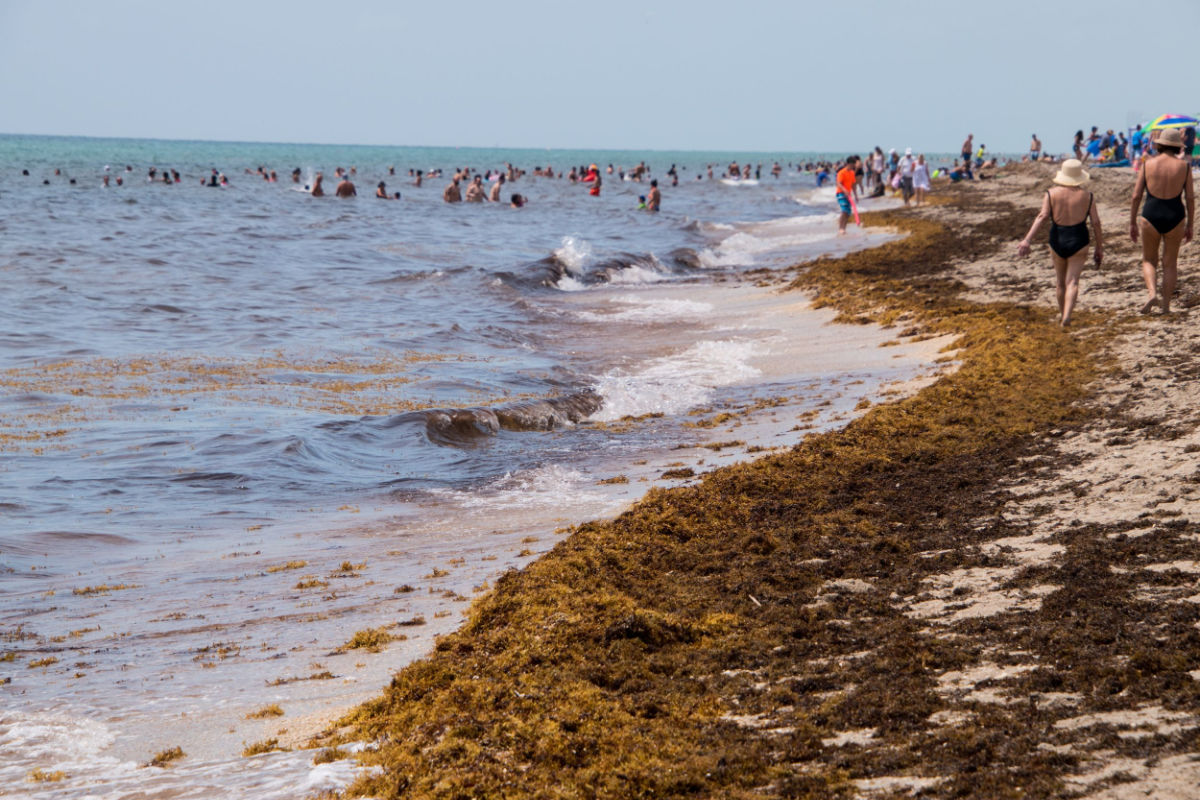[ad_1]
Last Updated
Visitors to coastal Florida might soon find an unwelcome visitor on their beaches.
Researchers are tracking what could be the largest recorded mass of sargassum seaweed to pass through the Caribbean and the Gulf of Mexico.

If correct in their predictions, masses of the foul-smelling seaweed will begin washing up on Florida’s beaches in the coming months.
What Is Sargassum?
Sargassum seaweed is a naturally occurring brown algae that blooms in the Atlantic Ocean each year.
When it washes up on beaches, it comes in droves and brings with it its rotten-egg smell.
The seaweed can form piles up to 6 feet tall on some beaches and will easily ruin a beach vacation if it is not removed.
As it rots, the algae releases smelly toxic hydrogen sulfide gasses, which can cause respiratory problems. Additionally, it can pose a threat to marine life, as it sucks oxygen from the water, creating dead zones.

What is unusual this year is the sheer volume of sargassum that is present and slowly moving towards much-loved beach destinations.
In speaking to CNN, researcher Dr. Brian Lapointe from Florida Atlantic University’s Harbor Branch Oceanographic Institute noted that a 5,000-mile-long and 200-300-mile-wide bloom of sargassum has formed between the coast of Africa all the way to the Gulf of Mexico.
The seaweed has doubled in size every month since November.
Top 5 Travel Insurance Plans For 2023 Starting At $10 Per Week
Easily Earn Points For Free Travel

Sargassum typically makes its way ashore in the Caribbean and the Gulf of Mexico each summer.
Although when and where it lands is up to mother nature, it predictably washes up in popular beach destinations like Cancun and Playa del Carmen between April and October.
This year, however, there have been reports of it arriving months earlier than expected.
Where Will It Land In Florida?
According to CBS News, South Florida is already seeing some sargassum arrive on its beaches.
Most years, the seaweed doesn’t begin to wash up until June or July, but there are already reports of its early arrival in Florida.
Last week saw large amounts land in the Florida Keys, leaving beachgoers and local officials to express concerns about what is to come.
The worry is that amounts will continue to grow, leaving a devastating impact on Florida’s beach communities.

Last summer, record amounts of sargassum landed on Miami’s beaches, and researchers are predicting that this year beaches on Florida’s east, south, and southeast coasts, as well as beaches along the Gulf of Mexico, will be a landing point for some of the sargassum.
The exact landing point is not known because the seaweed’s path depends largely on ocean currents and winds.
What Can Be Done About It?
Sargassum can cause massive damage to tourism industries that rely heavily on the reputation of beautiful beaches, such as Florida, Mexico, and the islands of the Caribbean, so it makes sense that officials try to mitigate its effects.
During tourist season in Barbados, workers use 1,600 dump trucks each day to clear the seaweed from beaches, while last year, the US Virgin Islands declared a state of emergency because of large amounts of sargassum.

Typically, municipal workers in beach areas will clear the seaweed early in the morning to ensure beachgoers are not disturbed.
But as the day goes on and tides come in, more seaweed washes up. So even if the beaches are cleared early in the day, by nightfall, they could be inundated once again.
It is a frustrating and expensive operation trying to manage it all.

Should You Change Your Travel Plans?
Given the impending arrival of sargassum, and the recent impact of red tide in southwest Florida, potential visitors might be wondering if they should change their plans.
There are a few things tourists should consider:

- Check with your hotel and local authorities in the area you plan to visit to see what type of sargassum management plan they have in place
- Monitor expected sargassum levels at your destination from trusted sources
- Choose a hotel or resort with a nice pool in case beach conditions are unfavorable
- While sargassum is a nuisance for beachgoers, keep in mind that it is generally not harmful to humans
- Remember that continuing to support regions whose economies rely heavily on tourism will only strengthen their ability to better manage future sargassum invasions
Read More:
Top 5 Travel Insurance Plans Starting At $10 Per Week
How To Easily Earn Points For Free Travel
↓ Join Our Community ↓
The Out Of Town Blogs Community FB group has all the latest reopening news, conversations, and Q&A’s happening daily!

SUBSCRIBE TO OUR LATEST POSTS
Enter your email address to subscribe to Out Of Town Blogs’s latest breaking travel news, straight to your inbox.
This article originally appeared on outoftownblogs.com
Opinions expressed here are the author’s alone, not those of any bank, credit card issuer, hotel, airline, or other entity. This content has not been reviewed, approved or otherwise endorsed by any of the entities included within the post.
[ad_2]
